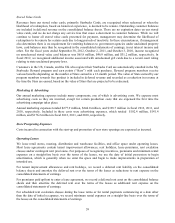Starbucks 2012 Annual Report Download - page 67
Download and view the complete annual report
Please find page 67 of the 2012 Starbucks annual report below. You can navigate through the pages in the report by either clicking on the pages listed below, or by using the keyword search tool below to find specific information within the annual report.61
tax position will be sustained on examination by the relevant taxing authorities, based on the technical merits of
our position. The tax benefits recognized in the financial statements from such a position are measured based on
the largest benefit that has a greater than 50% likelihood of being realized upon ultimate settlement. Starbucks
recognizes interest and penalties related to income tax matters in income tax expense.
Earnings per Share
Basic earnings per share is computed based on the weighted average number of shares of common stock
outstanding during the period. Diluted earnings per share is computed based on the weighted average number of
shares of common stock and the effect of dilutive potential common shares outstanding during the period,
calculated using the treasury stock method. Dilutive potential common shares include outstanding stock options
and RSUs. Performance-based RSUs are considered dilutive when the related performance criterion has been met.
Common Stock Share Repurchases
We may repurchase shares of Starbucks common stock under a program authorized by our Board of Directors,
including pursuant to a contract, instruction or written plan meeting the requirements of Rule 10b5-1(c)(1) of the
Securities Exchange Act of 1934. Under applicable Washington State law, shares repurchased are retired and not
displayed separately as treasury stock on the financial statements. Instead, the par value of repurchased shares is
deducted from common stock and the excess repurchase price over par value is deducted from additional paid-in
capital and from retained earnings, once additional paid-in capital is depleted.
Recent Accounting Pronouncements
In July 2012, the FASB issued guidance that revises the requirements around how entities test indefinite-lived
intangible assets, other than goodwill, for impairment. The guidance allows companies to perform a qualitative
assessment before calculating the fair value of the reporting unit. If entities determine, on the basis of qualitative
factors, that the fair value of the indefinite-lived intangible asset is more likely than not greater than the carrying
amount, a quantitative calculation would not be needed. The guidance will become effective for us at the
beginning of our first quarter of fiscal 2013. The adoption of this guidance will not have a material impact on our
financial statements.
In September 2011, the FASB issued guidance that revises the requirements around how entities test goodwill for
impairment. The guidance allows companies to perform a qualitative assessment before calculating the fair value
of the reporting unit. If entities determine, on the basis of qualitative factors, that the fair value of the reporting
unit is more likely than not greater than the carrying amount, a quantitative calculation would not be needed. We
early-adopted this guidance effective for our fiscal 2012 annual goodwill impairment test, which we performed
during the third fiscal quarter. The adoption of this guidance will result in a change in how we perform our
goodwill impairment assessment; however, it will not have a material impact on our financial statements.
In June 2011, the FASB issued guidance that revises the manner in which entities present comprehensive income
in their financial statements. The guidance requires entities to report the components of comprehensive income in
either a single, continuous statement or two separate but consecutive statements. The guidance will become
effective for us at the beginning of our first quarter of fiscal 2013. The adoption of this new guidance will result in
a change in how we present the components of comprehensive income, which is currently presented within our
consolidated statements of equity.
In May 2011, the FASB issued guidance to amend the fair value measurement and disclosure requirements. The
guidance requires the disclosure of quantitative information about unobservable inputs used, a description of the
valuation processes used, and a qualitative discussion around the sensitivity of the measurements. This guidance
became effective for us at the beginning of our second quarter of fiscal 2012. The adoption of this new guidance
did not have a material impact on our financial statements.
























